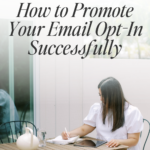How to Promote Your Email Opt-In Successfully
Table of Contents
ToggleSharing is caring!
Reading Time: 4 minutes
Imagine having a tribe of subscribers eager to read whatever content you create. Your very own online community presents limitless marketing opportunities for your business and beyond.
Opt-in email marketing, AKA permission marketing, is one of the most powerful promotional strategies for businesses of all sizes. It involves attracting potential subscribers using an opt-in form and gradually building a following through the power of communication. With a growing email list, you can promote, communicate, and generate MORE sales.
That said, there is no shortcut to building an email list; this has to be done correctly to collect qualified leads and prevent unsubscribes from users. Or worse, being tagged as a spammer.

Building Leads Using an Opt-In Form
The opt-in form serves as the invitation for website subscribers to sign up for your online community. You will use it to gather emails you add to your list of subscribers. To collect qualified leads, you need to market to the right people – individuals who genuinely want to hear from you.
With every successful signup, prospects are permitting you to send marketing messages to their email address. This also means that prospects will provide personal details, including email addresses. For GDPR-compliant websites, there must be an acknowledgement that the consumers agreed to receive marketing messages from your business.
Tips: Growing Your Email List
Keep it Short
Avoid asking for too much information on your email opt-in because not everyone has the time (or patience) to sit down and answer a long list of questions. Also, online users are generally wary of brands that ask too many questions; you don't want to scare people away with an overly complex signup form. Keep the questions short and straightforward – a top bar with a single field for emails will suffice.
Offer an Incentive
People aren't likely to give up their email addresses without a good reason. And a good trade-off would be a freebie called a lead magnet. An incentivized opt-in will attract more attention and be harder to pass up. The incentive doesn't have to be expensive; a short guide, an ebook, a mini online course, a cheat sheet, template, checklist, video, or even an infographic can be used as a freebie to sweeten the deal!
Use an Actual Form
Your offer will appeal more to people if you have an actual form on your website instead of inserting a link to the opt-in page. Not only is a proper opt-in form easier to optimize for SEO, but signing up for a form takes less work too. Posting a simple link that leads to the opt-in presents more steps to complete the signup process. People must click the link, complete the form, and click the CTA button. That's a lot of work for most people.
Using top bars, sliders, and similar tools to present the opt-in along with a form in your header, sidebar, or navigation, will make it easier for people to complete the signup process.
Set Expectations
Be completely transparent to build trust because people are wary of businesses that ask for their personal details. You don't want to confuse or irritate people by sending marketing messages so let them know precisely what they can expect when they sign up for your email list from the very beginning.
Where to Feature the Opt-In Form
Where are the best places to post the opt-in form? For maximum exposure, we highly suggest the following strategies:
Every website page: Post the opt-in form on every website page so people don't have to search for it. You don't want people to scroll past the opt-in because they keep missing it.
Post on the footer: Some website spaces work better than others but traditionally, the footer is a space used to outline essential website pages – including a lead magnet offer and a simple signup form.
Sidebar: The sidebar is a popular spot for a lead magnet offer and a simple signup form. It's always visible to website visitors, which guarantees optimal exposure. Some areas work better than others, so experiment on which side gets the most attention.
Where to Promote Your Email Opt-In
On Your Blog: You can create visuals that put the lead magnet and opt-in form front and centre on your website. You can also add signup pop-ups or graphics at the bottom of every blog post to encourage people to sign up to your email list. You can also write a feature post highlighting the signup incentive to encourage more sign-ups..
On Your Website: You can create a pop-up form that appears within a few seconds of scrolling or an exit-intent pop-up when a user navigates away from your website. You can also make a site banner set on your website's header so visitors won't miss the offer.
Social media channels: To make social media promotions successful, you need to figure out which platforms are most popular among your core audience. You can also use a service like Linktr.ee to promote different links in one place.
On Facebook, you can create a cover image with a link to the signup form along with a picture of the freebie and use the visuals as a pinned post. You can also link the visuals to your page button or post shoutouts that link to your signup form. You can post the link on your bio or publish a feature post about your signup offer on Instagram. On Pinterest, you can create pins for the freebies that potential subscribers will receive once they complete the email opt-in.
Product list: If you sell products online, you can add the signup offer with the freebie as a product. Visitors don't have to purchase the offer; this strategy is meant to promote the email opt-in to attract as many subscribers as possible.
To promote your email opt-in successfully, it should be marketed in places that potential subscribers frequent. It helps if you have a nice freebie to sweeten the deal.
Are you ready to grow your email list? Try these tips, and you'll gain more signups in no time!
Most Popular Posts:
Sharing is caring!
PLEASE COMMENT BELOW